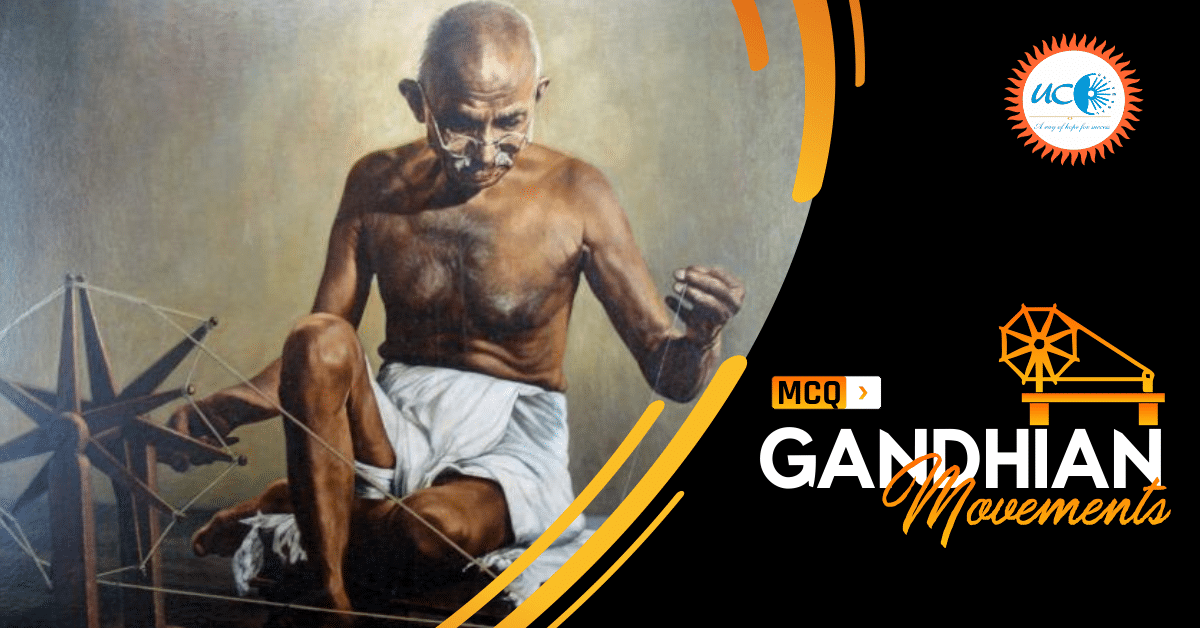MCQ’s On Gandhian Movements: Civil Disobedience Movement
1. In 1930, Mahatma Gandhi started the Civil Disobedience Movement from [1995]
(a) Sevagram
(b) Dandi
(c) Sabarmati
(d) Wardha
Ans (c)
2. The meeting of Indian and British political leaders during 1930–32 in London has often been referred to as the First, Second & Third Round Table Conferences. It would be incorrect to refer to them as such because: [1996]
(a) the Indian National Congress did not take part in two of them
(b) Indian parties other than the Indian National Congress, participating in the conference represented sectional interests and not the whole of India
(c) the British Labour Party had withdrawn from the conference thereby making the proceeding of the conference partisan
(d) It was an instance of a conference held in three sessions and not that of three separate conference
Ans (d)
3. The Poona Pact which was signed between the British Government and Mahatma Gandhi in 1934 provided for [1997]
(a) creation of dominion status for India
(b) separate electorates for the Muslims
(c) The separate electorate for the Harijans
(d) A joint electorate with the reservation for Harijans
Ans (d)
4. At which Congress session was the working committee authorized to launch a program of Civil Disobedience? [2005]
(a) Bombay (b) Lahore (c) Lucknow (d) Tripura
Ans (b)
5. Who drafted the resolution on fundamental rights for the Karachi Session of Congress in 1931? [2005]
(a) Dr. B.R. Ambedkar
(b) Pandit Jawaharlal Nehru
(c) Dr. Rajendra Prasad
(d) Sardar Vallabhbhai Patel
Ans (b)
6. Consider the following statements: [2005]
1. In the First Round Table Conference, Dr. Ambedkar demanded separate electorates for the depressed classes.
2. In the Poona Act, special provisions for the representation of the depressed people in the local bodies and civil services were made.
3. The Indian National Congress did not take part in the Third Round Table Conference.
Which of the statements given above is/are correct?
(a) 1 and 2 (b) 2 and 3 (c) 1 and 3 (d) 1, 2 and 3
Ans (c)
7. Which one of the following began with the Dandi March? [2009]
(a) Home Rule Movement
(b) Non-Cooperation Movement
(c) Civil Disobedience Movement
(d) Quit India Movement
Ans (c)
8. Mahatma Gandhi undertook fast unto death in 1932, mainly because [2012 – 1]
(a) Round Table Conference failed to satisfy Indian political aspirations
(b) Congress and the Muslim League had differences of opinion
(c) Ramsay Macdonald announced the Communal Award
(d) None of the statements (a), (b) and (c) given above is correct in this context
Ans (c)
9. Who of the following organized a march on the Tanjore coast to break the Salt Law in April 1930? [2015-I]
(a) V. O. Chidambaram Pillai
(b) C. Rajagopalachari
(c) K. Kamaraj
(d) Annie Besant
Ans (b)
Extra Questions:
1. How many days did Gandhi take to complete the Dandi March?
Ans: 25 days
2. Who were the women who participated in Dandi March?
Ans: Sarojini Naidu and Durga Bai Deshmukh
3. When was Salt Satyagraha launched?
Ans: 6th April 1930
4. Who launched the Satyagraha in Malabar?
Ans: K Kelappan
5. Who led the Satyagraha movement in Dharasana?
Ans: Sarojini Naidu
6. Who photographed the police atrocities in Dharasana and published in England?
Ans: Web Miller
7. Match the following:
1. Dharasana Satyagraha – a. T Prakasham
2. Mypadu Satyagraha – b. M P Nadkarni
3. Ankola Satyagraha – c. B Gopal Reddy
4. Merina Beach Satyagraha – d. Sarojini Naidu
Select from the codes given below:
a) 1-a, 2-c, 3-b, 4-d.
b) 1-d, 2-c, 3-b, 4-a
c) 1-b, 2-d, 3-a, 4-c.
d) 1-d, 2-a, 3-c, 4-b
Ans: (b)
8. Who was appointed as the salt dictator in Andhra state?
Ans: K Venkatappaiah
9. When was Gandhiji arrested during the civil disobedience movement?
Ans: May 1930
10. Who negotiated between Gandhi and Lord Irwin?
Ans: Tej Bahadur Sapru and C Y Chintamani.
11. Consider the following statements:
1. Lord Irwin promised release of all political prisoners except prisoners held guilty of violence.
2. The Civil Disobedience movement was not withdrawn.
3. Lord Irwin revoked the Salt Law.
Which among these are true for the Gandhi-Irwin pact 1931.
Codes:
a) 1 & 2 only. b) 2 & 3 only c) 3 only d) 1 & 3 only
Ans (d)
12. Who assisted Gandhi to participate in the Second Round Table Conference in London?
Ans: Sarojini Naidu
13. Which among the following movements received International Attention?
a) Swadeshi Movement
b) Non-Cooperation movement
c) Civil Disobedience movement
d) Quit India movement.
Ans (c)
14. Who among the following toured India on a Peace of Goodwill mission?
Ans: Bertrand Russell and HP Laski
15. Who established the All India Village Industries Association in 1934?
Ans: Gandhi
16. What is the Karachi Session of Congress March 1931 well known for?
a) Poorna Swaraj
b) Adoption of the Civil Disobedience Movement
c) Resolution of Fundamental Rights and National Economic Programme
d) Poona Pact
Ans (c)
17. Who replaced Lord Irwin as the viceroy of India?
a) Lord Willingdon
b) Lord Linlithgow
c) Lord Reading
d) Lord Wavell
Ans (b)
18. Who among the following was the founder of Khudai Khidmatgars?
a) C Rajagopalachari
b) Khan Abdul Gaffar Khan
c)Shaukatullah Ansari
d) M N Roy
Ans (b)
19. When was Bhagat Singh, Sukhdev and Rajguru executed?
Ans: 23 March 1931.
20. Consider the following statements:
1. The Communal Award was announced by Ramsay MacDonald in 1932.
2. The award allotted separate electorates to only Muslims, Sikhs & Christians.
3. Gandhi and the Congress accepted the decision of providing separate electorates to depressed classes.
Which of the following is correct?
a) 1 only b) 1 & 2 only c) 2 & 3 only d) 3 only
Ans (a)
21. Which day was observed as the day of fasting in 1932?
Ans: September 20
22. Which pact abandoned the separate electorates for depressed classes?
a) Gandhi-Irwin Pact
b) Delhi Pact
c) Lucknow Pact
d) Poona pact
Ans (d)
23. In which prison was Gandhi placed during the Civil disobedience movement?
Ans: Yerawada Jail, Pune.
24. Which association led the Civil Disobedience Movement in the North-West Frontier region?
a) Anushilan Samiti
b) Khudai Khidmatgars
c) Naujawan Bharat Sabha
d) Ghadr Party
Ans (b)
25. In which parts of India was the anti-Chowkidar campaign popular?
a) Bihar and Bengal
b) Tamil Nadu and Kerala
c) Karnataka and Tamil Nadu
d) United provinces
Ans (a)
26. How many seats were reserved for the depressed classes under the Poona Pact?
a) 78 b)120 c) 84 d) 147
Ans (d)
27. In which of the session of Round Table Conferences, Congress participation was there?
a) First b) Second and Third c) Third d) Second
Ans (d)
28. Who attended all the three Round Table conferences?
a) M A Jinnah b) Gandhi c) B R Ambedkar d) Sarojini Naidu
Ans (c)
29. When was the Civil Disobedience movement resumed?
Ans: January 1932
30. Arrange the following in chronological order
1. Gandhi began Dandi March.
2. Poona Pact.
3. Gandhi Irwin Pact.
4. Gandhi starts fast unto death.
Codes:
a) 4,2,3,1 b) 1,3,2,4 c) 1,3,4,2 d) 1,2,4,3
Ans (c)





